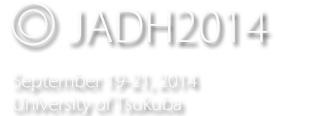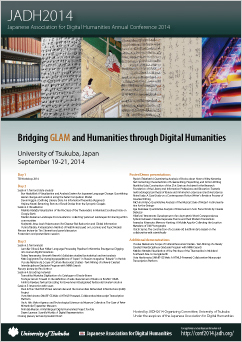Session 3-4
Scope of Cultural Resources Studies: Text-Mining of a Newly Created Interdisciplinary Graduate Program with MIMA Search
- Yusuke Nakamura (University of Tokyo)
- Hideki Mima (University of Tokyo)
- Katsuya Masuda (University of Tokyo)
- Chikahiko Suzuki (University of Tokyo)
How do interdisciplinary research/education programs develop to form their own style and find their own niche in the midst of a cluster of various specialized competing disciplines in higher education institutions? In this short paper, we report the preliminary results of mining of texts related to a new graduate program created in the Graduate School of Humanities and Sociology, University of Tokyo in 2000. For the text mining and visualizations, we used MIMA (Mining Information for Management and Acquisition) Search, a search engine developed by Mima for extracting and visualizing relationships among texts using Natural Language Processing.
The program is named “Cultural Resources Studies” (hereafter, CRS), and characterized by humanities-based interdisciplinarity and the linkage with practitioners of cultural activities. As the main target of the analysis, we focus on the creation of M.A. theses for the following reasons. First, M.A. students tend to pursue the themes not covered by other disciplines (one major reason why they chose the CRS). The seminars offered also tend to cover a variety of topics in ways that are more experimental as compared to traditional humanities curricula. Second, many M.A. students are writing a truly academic paper for the first time, and yet there has not been an established model to follow as a CRS M.A. thesis. Thus, when examined as a group, the M.A. theses of the first decade of the CRS program reveal us an interesting case of collective efforts to create a new form of interdisciplinary studies from scratch.
We have already analyzed two categories of texts related to the CRS program since its foundation: (1) syllabi of lectures and seminars (a total of about 600), (2) summaries (less than 40,000 characters) attached to M.A. theses (a total of 76). The cluster analysis of syllabi and thesis summaries reveals the emergence of a few stable clusters of related terms that can be represented by the high-ranking terms such as “management” and “exhibition.” However, for the rest they are so diverse that it is difficult to choose a particular term as a representative label. We interpret this result as a delicate balance between an attractive force toward practical applications and a repulsive force toward a search for diverse cultural resources hitherto understudied.
Now we are extending our analysis to the institutions referred to in the M.A. theses. There are a total of about 2,500 institutions in our database, from universities to private companies. We have selected 257 institutions that (i) have issued periodicals, (ii) are referred to twice or more, and (iii) have web pages. We are analyzing their attributes and basic documents (such as mission statements and manifestos) to study what kinds of institutions our M.A. students have considered as the key organizations for the study of cultural resources in modern Japan.
In the presentation, we will show the results of analysis of the up-to-date data to examine the present scope of the CRS program, and discuss the methods for monitoring the scope of ongoing interdisciplinary research/education programs.
- Keywords
- interdisciplinary research/education program, text mining, visualization

